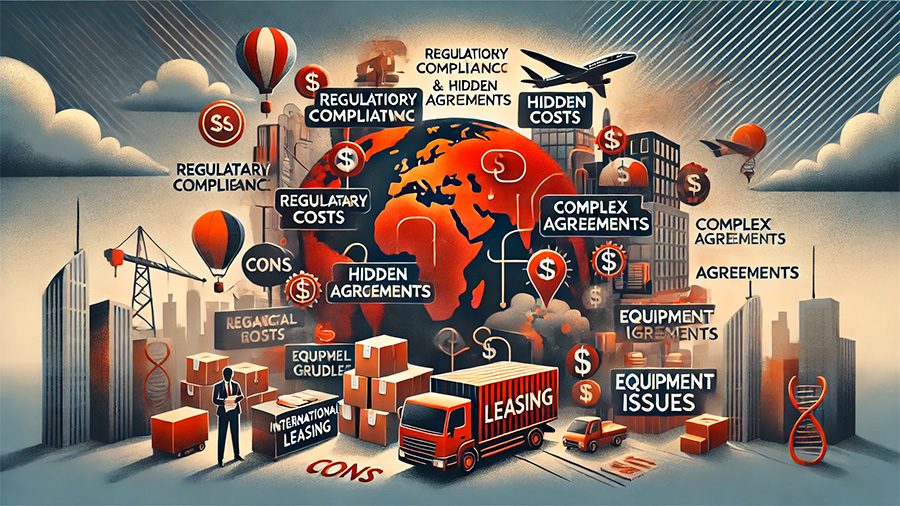For global businesses looking to expand or operate across multiple markets, leasing internationally can offer a flexible and cost-effective solution for acquiring equipment, property, or technology. International leasing agreements allow companies to access the resources they need without the significant upfront costs of ownership, providing financial flexibility in managing diverse operations. However, leasing across borders comes with unique challenges, including legal complexities, currency fluctuations, and compliance with local regulations.
This article explores the pros and cons of international leasing for global businesses, helping decision-makers understand the benefits and potential pitfalls of leasing across borders.
Pros of International Leasing
One of the primary benefits of international leasing is the financial flexibility it provides. Leasing allows businesses to spread out the cost of expensive equipment or property over time, preserving capital for other strategic investments such as product development, market expansion, or hiring. This is particularly valuable for businesses that need to operate in multiple markets where the cost of purchasing assets outright can strain resources.
Another major advantage is access to the latest technology and equipment. In industries where technology evolves rapidly, leasing ensures that businesses can keep up with advancements without being locked into outdated equipment. Global businesses can lease cutting-edge equipment in different countries, ensuring that they remain competitive and efficient in all of their markets. At the end of the lease term, companies have the flexibility to upgrade to newer models, avoiding the risks of owning obsolete equipment.
Leasing internationally also provides flexibility for project-based needs. Many businesses that operate across borders work on diverse projects with varying timelines. Leasing gives companies the ability to scale their operations according to project requirements. Instead of purchasing equipment that may only be needed for a limited period, businesses can lease it for the duration of the project and return it afterward, avoiding long-term ownership costs.
For companies that need to enter new markets quickly, international leasing offers a faster entry by allowing businesses to set up operations without having to go through the lengthy process of purchasing and importing equipment. Leasing local equipment can be a much faster option, especially when time-sensitive projects are involved.

Cons of International Leasing
While leasing internationally has significant benefits, it also presents several challenges. One of the biggest concerns is legal complexities. Different countries have different legal frameworks and regulations governing leasing agreements. This can lead to complications if businesses are unfamiliar with local laws, particularly in areas like contract enforcement, property rights, and taxation. Global companies need to work closely with legal experts to ensure that their leasing agreements comply with the laws of each country they operate in.
Another challenge is currency fluctuations. When leasing equipment in another country, businesses often deal with payments in foreign currencies, which can expose them to exchange rate risk. If the value of the local currency fluctuates significantly, it can increase the cost of the lease unexpectedly. For businesses operating in volatile currency markets, this risk can be mitigated by negotiating payment terms in a more stable currency or using hedging strategies to manage currency exposure.
Tax implications are another factor to consider when leasing internationally. Different countries have varying tax laws that can affect the cost of the lease, including VAT, import duties, or withholding taxes. These additional taxes can increase the overall cost of leasing, making it less financially attractive. Businesses must work with tax advisors to understand the full scope of tax obligations in each country and optimize their leasing strategy to reduce tax liability.
Compliance and Local Standards
International leasing agreements may also require compliance with local standards and regulations regarding equipment safety, environmental impact, and operational performance. In some countries, leased equipment may need to meet specific certification requirements, adding complexity to the leasing process. Businesses must ensure that the equipment they lease is in compliance with local laws and regulations to avoid penalties, fines, or operational disruptions.
Moreover, differences in maintenance and repair expectations across countries can complicate leasing agreements. In some markets, the lessee may be responsible for maintenance, while in others, the lessor may handle repairs and upkeep. These differing expectations can impact the overall cost of the lease and must be clearly defined in the contract.

Balancing Flexibility and Risk
Ultimately, international leasing offers global businesses a high degree of flexibility, but it comes with risks that need to be carefully managed. By understanding the local legal, financial, and operational challenges of leasing in different markets, businesses can make more informed decisions about whether leasing is the right strategy for their international expansion or operations.
For some companies, the benefits of leasing—such as preserving capital, accessing the latest technology, and maintaining operational flexibility—outweigh the challenges of navigating complex legal and financial environments. However, for others, the risks of currency fluctuations, legal complexities, and tax implications may make leasing a less attractive option compared to purchasing.
Conclusion
International leasing can provide global businesses with the flexibility they need to grow and operate across multiple markets. By leasing equipment, property, or technology, companies can reduce upfront costs, stay current with the latest innovations, and scale operations efficiently. However, businesses must carefully consider the potential challenges, including legal complexities, currency risks, and local compliance requirements, to make the most of international leasing agreements. With careful planning and expert guidance, leasing can be a valuable tool for global growth.









